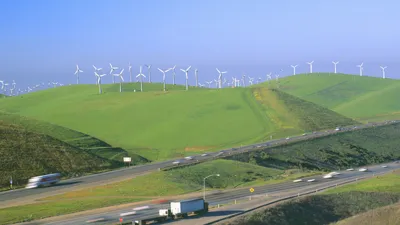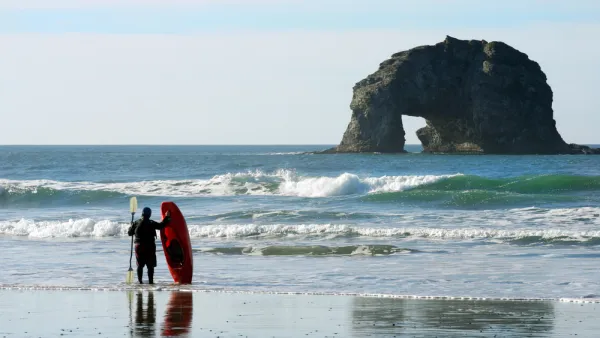California has been lonely for the last seven years as the only state that prices carbon emissions from most sources. Oregon is expected to decide this month whether to join them.

"California set itself up to be a global leader in reducing greenhouse gas emissions, but it never intended to go it alone," reports Rachel Becker for CALmatters, a nonpartisan, nonprofit journalism venture. While many states share the same commitment to fighting climate change, no other state has followed in its footsteps by pricing carbon emissions from most sources.
A bill winding its way through the Oregon legislature could finally give California a U.S. partner in the cap-and-trade program [pdf] it shares with the Canadian province of Quebec.
“California really led with all-in, and I want Oregon to be all-in, too,” said Oregon state representative Karin Power, a Democrat who co-chairs the Joint Committee on Carbon Reduction spearheading the bill. “We can do this. We know that science tells us we have to.”
Unlike the nine New England and Mid-Atlantic states that comprise the Regional Greenhouse Gas Initiative, a carbon cap-and-trade program which applies only to power generation, House Bill 2020 would establish the Oregon Climate Action Program which "[p]laces an overall limit across total emissions from regulated sectors to achieve the state’s greenhouse gas goals," according to the 5-page summary [pdf].
A key part of the market-based cap-and-trade program is the role played by emission allowances, described in the program's FAQ:
The state distributes a fixed quantity of emissions allowances each year. Each allowance permits an entity to produce 1 ton of emissions per year. Large emitters who are covered by the program either reduce emissions or acquire an emissions allowance. Emitters can acquire an allowance directly through auction, through trade with other entities, or in certain cases, they may receive allowances directly from the state.
Carbon prices
"The California Air Resources Board just released the results from the latest – the 15th – joint California-Quebec cap-and-trade auction, and the program seems to be performing as hoped," reported Melanie Curry for Streetsblog California on May 22. "[A]ll of the “current” allowances were sold this time, at a price of $17.45 per metric ton, which is $1.83 above the floor price of $15.62."
The price for emitting a ton of carbon dioxide or equivalent has increased $7.36, or 73 percent, since its first auction in November 2012 about 6 and one-half years ago.
Path to success
"Oregon’s bill still needs to survive the House and the Senate before it ends up on the governor’s desk by the end of June," adds Becker on June 6.
Still, its chances are looking good with a Democrat supermajority in the Oregon legislature. [HB 2020] sets ambitious targets for greenhouse gas reductions over the next 30 years: 45 percent below 1990 levels by 2035 and 80 percent below 1990 levels by 2050.
Becker goes on to describe other aspects cap-and-trade, and possible constitutional challenges with the program that would increase energy prices, which is the subject of a June 4 Willamette Week article by Nigel Jaquiss.
One issue to watch is whether the sale of allowances would be tantamount to a new tax, triggering the three-fifths supermajority requirement established by voters in 1996. Sen. Michael Dembrow (D-Portland), the chief sponsor of HB 2020, believes it would need only a majority threshold.
Related in Planetizen:
-
Oregon Democrats Unveil Cap-and-Trade Bill, February 12, 2019
-
Advocates for Oregon's Carbon Pricing Plan Proceed Cautiously, December 12, 2018
FULL STORY: No longer the loneliest? Why Oregon’s all-in climate push matters to California

National Parks Layoffs Will Cause Communities to Lose Billions
Thousands of essential park workers were laid off this week, just before the busy spring break season.

Retro-silient?: America’s First “Eco-burb,” The Woodlands Turns 50
A master-planned community north of Houston offers lessons on green infrastructure and resilient design, but falls short of its founder’s lofty affordability and walkability goals.

Delivering for America Plan Will Downgrade Mail Service in at Least 49.5 Percent of Zip Codes
Republican and Democrat lawmakers criticize the plan for its disproportionate negative impact on rural communities.

Test News Post 1
This is a summary

Test News Headline 46
Test for the image on the front page.

Balancing Bombs and Butterflies: How the National Guard Protects a Rare Species
The National Guard at Fort Indiantown Gap uses GIS technology and land management strategies to balance military training with conservation efforts, ensuring the survival of the rare eastern regal fritillary butterfly.
Urban Design for Planners 1: Software Tools
This six-course series explores essential urban design concepts using open source software and equips planners with the tools they need to participate fully in the urban design process.
Planning for Universal Design
Learn the tools for implementing Universal Design in planning regulations.
EMC Planning Group, Inc.
Planetizen
Planetizen
Mpact (formerly Rail~Volution)
Great Falls Development Authority, Inc.
HUDs Office of Policy Development and Research
NYU Wagner Graduate School of Public Service





























